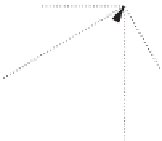Environmental Engineering Reference
In-Depth Information
y
y'
V
x'
O
q
x
Figure 11.1 Two different frames of reference,
T
and
T
, which differ by a rotation through
an angle
θ
.
Rotations
Let us be even more specific and consider two frames of reference that differ by
a rotation through an angle
θ
about the
z
-axis, as illustrated in Figure 11.1. The
components of a general vector
V
in the two frames are related to each other by
V
1
=
V
1
cos
θ
+
V
2
sin
θ,
(11.2)
V
2
=−
+
V
1
sin
θ
V
2
cos
θ,
(11.3)
V
3
=
V
3
.
(11.4)
Equivalently we may write (using the summation convention introduced in
Eq. (8.7))
V
i
=
R
ij
V
j
,
(11.5)
where the entries
R
ij
can be expressed via the matrix
cos
θ
sin
θ
0
.
R
=
−
sin
θ
cos
θ
0
0
(11.6)
0
1
As we shall soon see, a particularly important property of this matrix is that it is
orthogonal, which means that
R
T
R
=
1
(11.7)
or, in component form,
R
ji
R
jk
=
δ
ik
.
(11.8)
It is therefore a trivial exercise to obtain the inverse of an orthogonal matrix:
one just takes the transpose:
R
−
1
R
T
,i.e.
(R
−
1
)
ij
=
=
R
ji
. As an aside it is very
common to see Eq. (11.5) written as
V
=
RV
.
(11.9)







